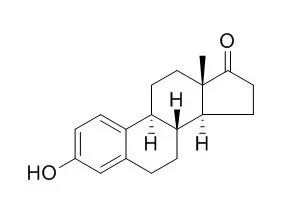| Description: |
Estrone,a steroid known to play an important role as precursor of 17 beta-estradiol,especially in postmenopausal women, it inhibits the BCRP-mediated drug efflux and overcome drug resistance.The widely distributed estrone esters in food and their relatively high concentrations may result in high free hormone intakes in humans, the continued and massive intake of estrone may enhance tissue deposition and lead to obesity. |
| Targets: |
Estrogen receptor | Progestogen receptor |
| In vitro: |
| J Hazard Mater. 2015 May 29;299:112-121. | | The effect of particle size on sorption of estrogens, androgens and progestagens in aquatic sediment.[Pubmed: 26094244] | There is growing concern about the biologic effects of steroid hormones in impacted waterways. There is increasing evidence of enhanced transport and biological effects stemming from steroid hormones associated with soils or sediments; however, there are limited studies evaluating how steroid hormone distribution between various particle sizes within whole sediments affects steroid fate.
METHODS AND RESULTS:
In this study, sorption of 17β-estradiol, Estrone, progesterone, and testosterone was evaluated to different size fractions of two natural sediments, a silty loam and a sandy sediment, to determine the steroid sorption capacity to each fraction and distribution within the whole sediment. Sorption isotherms for all steroid hormones fit linear sorption models. Sorption capacity was influenced more by organic carbon content than particle size. Interactions between size fractions were found to affect the distribution of steroids within the whole sediments. All four steroids preferentially sorbed to the clay and colloids in the silty loam sediment at the lowest aqueous concentration (1 ng/L) and as aqueous concentration increased, the distribution of sorbed steroid was similar to the distribution by weight of each size fraction within the whole sediment.
CONCLUSIONS:
In the sandy sediment, preferential sorption to fine particles was observed. | | Jpn J Cancer Res. 2002 Mar;93(3):231-5. | | Estrone and 17beta-estradiol reverse breast cancer resistance protein-mediated multidrug resistance.[Pubmed: 11927002] | Breast cancer resistance protein (BCRP), an adenosine triphosphate-binding cassette transporter, confers resistance to a series of anticancer reagents, including mitoxantrone, SN-38 and topotecan.
METHODS AND RESULTS:
In the present study, we found that Estrone and 17beta-estradiol potentiated the cytotoxicity of mitoxantrone, SN-38 and topotecan in BCRP-transduced K562 cells (K562 / BCRP). These estrogens showed only a marginal effect, or none, in parental K562 cells. Estrone and 17beta-estradiol increased the cellular accumulation of topotecan in K562 / BCRP cells, but not in K562 cells, suggesting that these estrogens inhibit the BCRP-mediated drug efflux and overcome drug resistance. |
|
| In vivo: |
| Eur J Nutr. 1999 Oct;38(5):247-53. | | Estrone in food: a factor influencing the development of obesity?[Pubmed: 10654162] | Estrone is a relatively abundant hormone widely distributed in tissues of animal and plant origin. It is a mild estrogen that induces increases in body weight in experimental animals. The relative abundance of Estrone esters in animal tissues suggests that it may also be found in foods, from which it may alter the mechanisms of body weight control.
To measure the total Estrone content in food and to determine whether this may affect body weight.
METHODS AND RESULTS:
In the first part of the study, a method was devised for the measurement of total Estrone content in food. This was applied to the analysis of Estrone content in a variety of food. Finally, hyperlipidic diets (18.6 MJ/kg) with a total Estrone content 0.89 +/- 0.21 mumol/kg (control group) and 1.37 +/- 0.13 mumol/kg (laced with Estrone fatty esters) were given to rats during 15 days, in order to determine the influence of dietary Estrone on the body mass. Zucker lean (Fa/?) rats weighing initially 200-215 g were used. The total Estrone (essentially as fatty esters) content of food was investigated by combining a dried methanol extraction with saponification and measurement of the free Estrone evolved through radioimmunoassay.
The content of Estrone was zero in some vegetables, but significant in fruits, meats, and especially fats, both of plant and animal origin. The application of these analyses to a standard recommended diet for humans may result in intakes of more than 1 mumol of Estrone per day, a figure comparable to the estrogen production by women. When rats were exposed to a raised Estrone content in a fat-rich diet, they significantly increased their body weights, doubling their rate of growth (1.99 g/day) compared with controls (0.81 g/day), but maintaining their plasma composition and the proportions of lipid, water, and protein in their carcasses.
CONCLUSIONS:
The widely distributed Estrone esters in food and their relatively high concentrations may result in high free hormone intakes in humans. The continued and massive intake of Estrone may enhance tissue deposition and lead to obesity. |
|






 Cell. 2018 Jan 11;172(1-2):249-261.e12. doi: 10.1016/j.cell.2017.12.019.IF=36.216(2019)
Cell. 2018 Jan 11;172(1-2):249-261.e12. doi: 10.1016/j.cell.2017.12.019.IF=36.216(2019) Cell Metab. 2020 Mar 3;31(3):534-548.e5. doi: 10.1016/j.cmet.2020.01.002.IF=22.415(2019)
Cell Metab. 2020 Mar 3;31(3):534-548.e5. doi: 10.1016/j.cmet.2020.01.002.IF=22.415(2019) Mol Cell. 2017 Nov 16;68(4):673-685.e6. doi: 10.1016/j.molcel.2017.10.022.IF=14.548(2019)
Mol Cell. 2017 Nov 16;68(4):673-685.e6. doi: 10.1016/j.molcel.2017.10.022.IF=14.548(2019)